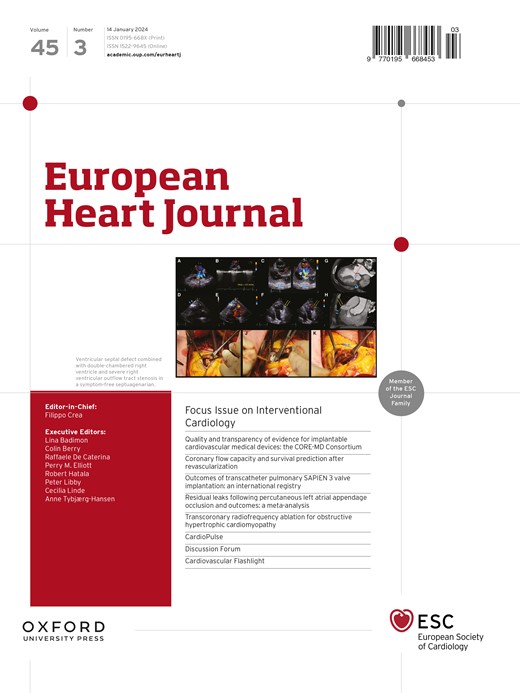First myocardial infarction: risk factors, symptoms, and medical therapy.
IF 35.6
1区 医学
Q1 CARDIAC & CARDIOVASCULAR SYSTEMS
引用次数: 0
Abstract
BACKGROUND AND AIMS Despite the implementation of clinical risk algorithms based on traditional risk factors, the global burden of atherosclerotic cardiovascular disease has continued to rise over the past decades. There are few real-world data on prevalence of both symptoms and risk factors prior to myocardial infarction (MI). This study aimed to investigate the prevalence of documented coronary artery disease risk factors, documented symptoms, physician visits, and preventive therapy uptake prior to first MI. METHODS In this retrospective cohort study, US patients ≥18 years with a first MI [International Classification of Diseases, 10th Revision (ICD-10) definition] between 1 January 2017 and 30 September 2022 were included from the Clarivate Real-World Data Product that links electronic health records, medical claims, and pharmacy claims from 98% of government and commercial health insurance plans in the US. Prevalence of previously ICD-10 documented cardiac symptoms and standard modifiable risk factors (SMuRFs), physician visits, and use of preventive medical therapy were assessed prior to MI. RESULTS The study identified 4 657 412 patients with a first MI (2017-2022), with a median age of 70 years; 42.3% were women. Prior to MI, 50.5% of patients had no documented symptoms, 18.0% had no SMuRFs, 22.2% did not have documented physician visits, and 63.4% were not prescribed any preventive therapy. Individuals ≤60 years and men were less likely to have documented symptoms and SMuRFs, had lower frequency of primary care physician visits, used less preventive therapy, and had more frequent occurrence of ST-elevation MI than individuals >60 years and women, respectively. CONCLUSIONS In a large real-world dataset, half of the patients with first MI did not have documented antecedent symptoms, and approximately 1 in 5 had no previously identified SMuRFs. The majority of those who visited a physician prior to the MI with identified SMuRFs and symptoms were not using any preventive medical therapy. These findings highlight an urgent unmet need for improved tools to identify patients at risk of MI who may benefit from preventive therapy.首次心肌梗死:危险因素、症状和药物治疗。
背景和目的尽管基于传统危险因素的临床风险算法得到了实施,但在过去几十年中,动脉粥样硬化性心血管疾病的全球负担仍在持续上升。关于心肌梗死(MI)前症状和危险因素的患病率的实际数据很少。该研究旨在调查首次心肌梗死前记录的冠状动脉疾病危险因素、记录的症状、医生就诊和预防性治疗的流行情况。方法在这项回顾性队列研究中,2017年1月1日至2022年9月30日期间患有首次心肌梗死(国际疾病分类,第10版(ICD-10)定义)的美国患者≥18岁,纳入Clarivate真实世界数据产品,该数据产品与电子健康记录、医疗索赔和药房索赔来自美国98%的政府和商业健康保险计划。在心肌梗死发生前,评估了先前ICD-10记录的心脏症状和标准可改变危险因素(smurf)的患病率、医生就诊情况和预防性药物治疗的使用情况。结果研究确定了4657412例首次心肌梗死患者(2017-2022),中位年龄为70岁;42.3%为女性。在心肌梗死之前,50.5%的患者没有症状记录,18.0%没有smurf记录,22.2%没有医生就诊记录,63.4%没有开任何预防性治疗处方。≤60岁的个体和男性有记录的症状和smurf的可能性较小,初级保健医生就诊频率较低,预防性治疗较少,st段抬高心肌梗死的发生频率分别高于≤60岁的个体和女性。结论:在一个庞大的现实世界数据集中,一半的首次心肌梗死患者没有记录的先前症状,大约五分之一的患者先前没有发现smurf。大多数在心肌梗死前就诊并确定smurf和症状的患者没有使用任何预防性药物治疗。这些发现强调了迫切需要改进工具来识别可能受益于预防性治疗的心肌梗死风险患者。
本文章由计算机程序翻译,如有差异,请以英文原文为准。
求助全文
约1分钟内获得全文
求助全文
来源期刊

European Heart Journal
医学-心血管系统
CiteScore
39.30
自引率
6.90%
发文量
3942
审稿时长
1 months
期刊介绍:
The European Heart Journal is a renowned international journal that focuses on cardiovascular medicine. It is published weekly and is the official journal of the European Society of Cardiology. This peer-reviewed journal is committed to publishing high-quality clinical and scientific material pertaining to all aspects of cardiovascular medicine. It covers a diverse range of topics including research findings, technical evaluations, and reviews. Moreover, the journal serves as a platform for the exchange of information and discussions on various aspects of cardiovascular medicine, including educational matters.
In addition to original papers on cardiovascular medicine and surgery, the European Heart Journal also presents reviews, clinical perspectives, ESC Guidelines, and editorial articles that highlight recent advancements in cardiology. Additionally, the journal actively encourages readers to share their thoughts and opinions through correspondence.
 求助内容:
求助内容: 应助结果提醒方式:
应助结果提醒方式:


